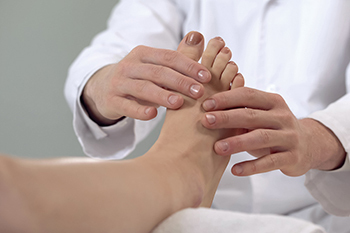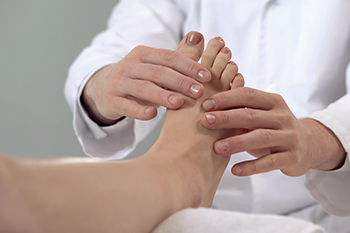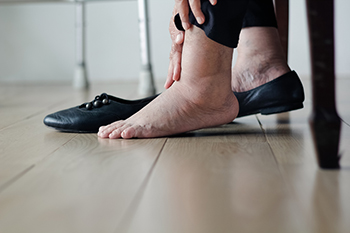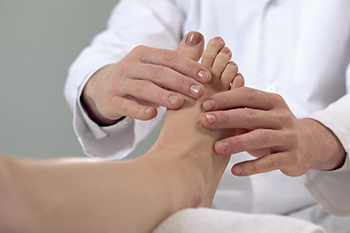Blog
Items filtered by date: September 2022
Treating Bunions

Bunions are a common affliction of the foot where a bony bump develops on the side of the big toe. This causes the top of the big toe to point towards the second toe, and the structure of the big toe’s bones can be manipulated. A medical professional, such as a podiatrist (a foot specialist), may recommend to you several different treatment options for your bunions short of a surgical procedure. For instance, it might be recommended to take nonsteroidal anti-inflammatory medications to minimize inflammation. Also, a podiatrist might recommend avoiding physical activities that exacerbate symptoms of bunions or wearing footwear that provides more space in the toe box area. Lastly, a podiatrist may recommend applying an ice pack to your bunions several times a day to reduce inflammation. Contact a podiatrist today if you have a case of bunions.
If you are suffering from bunions, contact one of our podiatrists of Romeo Foot & Ankle Clinic. Our doctors can provide the care you need to keep you pain-free and on your feet.
What Is a Bunion?
A bunion is formed of swollen tissue or an enlargement of boney growth, usually located at the base joint of the toe that connects to the foot. The swelling occurs due to the bones in the big toe shifting inward, which impacts the other toes of the foot. This causes the area around the base of the big toe to become inflamed and painful.
Why Do Bunions Form?
Genetics – Susceptibility to bunions are often hereditary
Stress on the feet – Poorly fitted and uncomfortable footwear that places stress on feet, such as heels, can worsen existing bunions
How Are Bunions Diagnosed?
Doctors often perform two tests – blood tests and x-rays – when trying to diagnose bunions, especially in the early stages of development. Blood tests help determine if the foot pain is being caused by something else, such as arthritis, while x-rays provide a clear picture of your bone structure to your doctor.
How Are Bunions Treated?
- Refrain from wearing heels or similar shoes that cause discomfort
- Select wider shoes that can provide more comfort and reduce pain
- Anti-inflammatory and pain management drugs
- Orthotics or foot inserts
- Surgery
If you have any questions, please feel free to contact our offices located in Washington and Shelby Townships, MI . We offer the newest diagnostic and treatment technologies for all your foot care needs.
Gout and How It Affects the Feet

Gout is a type of inflammatory arthritis that can cause severe pain in and around affected joints, often in the big toe. Gout is most common in older men. Symptoms include swelling, redness, tenderness, and severe pain in the affected joint. This condition, left untreated, can worsen. Gout attacks usually occur on the joint at the base of the big toe, but can affect every other joint in the foot. Many joints can be affected at once. Attacks happen quickly and can become worse. They may subside after a week or take longer to to heal. The primary cause of gout is an accumulation of uric acid in the body. This happens because of the breakdown of chemicals in the body known as purines. Usually, uric acid is secreted through the kidneys and urine, but when it is not, the substance begins to form crystals, which settle around joints, under skin, and even in internal organs. Eventually they find their way into spaces between bones that form a joint and begin to rub against joint linings, causing pain and inflammation. If you feel pain in your big toe, please see a podiatrist who can properly diagnose gout and provide appropriate treatment.
Gout is a foot condition that requires certain treatment and care. If you are seeking treatment, contact one of our podiatrists from Romeo Foot & Ankle Clinic. Our doctors will treat your foot and ankle needs.
What Is Gout?
Gout is a type of arthritis caused by a buildup of uric acid in the bloodstream. It often develops in the foot, especially the big toe area, although it can manifest in other parts of the body as well. Gout can make walking and standing very painful and is especially common in diabetics and the obese.
People typically get gout because of a poor diet. Genetic predisposition is also a factor. The children of parents who have had gout frequently have a chance of developing it themselves.
Gout can easily be identified by redness and inflammation of the big toe and the surrounding areas of the foot. Other symptoms include extreme fatigue, joint pain, and running high fevers. Sometimes corticosteroid drugs can be prescribed to treat gout, but the best way to combat this disease is to get more exercise and eat a better diet.
If you have any questions please feel free to contact our offices located in Washington and Shelby Townships, MI . We offer the newest diagnostic and treatment technologies for all your foot and ankle needs.
Swollen Feet and Salt

Swollen feet occur when your feet increase in size due to a concentration of fluids in the feet. It can also commonly impact the ankles. There are many different causes of swollen feet. For example, pregnancy, injuries, insect bites, and infections are just some of the many potential causes of swollen feet. However, one cause of swollen feet that is sometimes overlooked is high salt intake. A diet that is high in salt facilitates the retention of water in the body, which can ultimately cause swollen feet. To prevent this from occurring, an individual might consider adjusting their diet. Not only can one reduce their salt intake by not using salt shakers, but avoiding packaged/processed foods that are high in salt can also be helpful. Salt can be frequently found in these packaged foods as a kind of preservative. You might also consider reducing the number of processed meats that you consume, as some of these meats are high in salt as well. Salt substitutes such as potassium iodide might also be worth incorporating into your diet to limit salt intake. As with anything, it is always best to consult first with a medical professional. If you have swollen feet and believe that it might be linked to your salt intake, schedule an appointment with a podiatrist today.
Swollen feet can be a sign of an underlying condition. If you have any concerns, contact one of our podiatrists of Romeo Foot & Ankle Clinic. Our doctors can provide the care you need to keep you pain-free and on your feet.
Swollen feet are a common ailment among pregnant women and people who stand or sit for extended periods. Aging may increase the possibility of swollen feet and patients who are obese often notice when their feet are swelling too. There may be medical reasons why swollen feet occur:
- Phlebitis - A condition that causes the veins to become inflamed and can also cause leg pain.
- Liver disease - This may lead to low blood levels of albumin which is a protein. This can cause fluid in the blood to pass into the tissues and several areas of the body can become swollen.
- Heart failure - When the heart doesn’t pump properly the blood that is normally pumped back to the heart can pool in the veins of the legs causing swollen feet.
- Kidney disease - One of the main functions of the kidneys is releasing excess fluid in the body. This type of condition can make it difficult for the kidneys to function properly, and as a result the feet may become swollen.
- Deep-vein thrombosis (DVT)- This is a serious condition where blood clots form in the veins of the legs. They can block the return of blood from the legs to the heart which may cause the feet to swell. It is important to be treated by a podiatrist if this condition is present.
Swollen feet can also be caused by bone and tendon conditions, including fractures, arthritis, and tendinitis. Additionally, there may be skin and toenail conditions and an infection may cause the feet to swell. Patients who take medicine to treat high blood pressure may be prone to getting swollen feet.
Many patients elevate their feet to help relieve the swelling and this is generally a temporary remedy. When a podiatrist is consulted the reason behind the swelling can be uncovered and subsequently treated.
If you have any questions please feel free to contact our offices located in Washington and Shelby Townships, MI . We offer the newest diagnostic tools and technology to treat your foot and ankle needs.
Why Live with Pain and Numbness in Your Feet?
Various Reasons Why a Heel Spur May Develop

People who develop heel spurs are aware of the pain and discomfort they may cause. It is defined as a bony growth on the back of the heel and between the arch, and is generally felt while walking and running. It is a calcium deposit, and wearing shoes that do not fit correctly may increase the risk of getting a heel spur. They may be one of three shapes, including pointed, shelf-like, and hooked, and may be up to a half inch long. The common symptoms that many patients experience can consist of a chronic ache in the heel of the foot, and there may be inflammation and swelling in the affected area. Additionally, it is often tender to the touch, and it may feel warm. A heel spur happens as a result of strained ligaments and muscles that gradually wear out the soft tissues in the heel. People who have experienced a heel injury, are overweight, or who frequently run and jump on hard surfaces, may be at a greater risk for developing a heel spur. Mild relief can come from resting the affected foot as often possible, and wearing shoes that have adequate support and cushioning. If you have been afflicted by a heel spur, it is suggested that you confer with a podiatrist who can recommend correct treatment options, which may include surgery for permanent removal.
Heel spurs can be incredibly painful and sometimes may make you unable to participate in physical activities. To get medical care for your heel spurs, contact one of our podiatrists from Romeo Foot & Ankle Clinic. Our doctors will do everything possible to treat your condition.
Heels Spurs
Heel spurs are formed by calcium deposits on the back of the foot where the heel is. This can also be caused by small fragments of bone breaking off one section of the foot, attaching onto the back of the foot. Heel spurs can also be bone growth on the back of the foot and may grow in the direction of the arch of the foot.
Older individuals usually suffer from heel spurs and pain sometimes intensifies with age. One of the main condition's spurs are related to is plantar fasciitis.
Pain
The pain associated with spurs is often because of weight placed on the feet. When someone is walking, their entire weight is concentrated on the feet. Bone spurs then have the tendency to affect other bones and tissues around the foot. As the pain continues, the feet will become tender and sensitive over time.
Treatments
There are many ways to treat heel spurs. If one is suffering from heel spurs in conjunction with pain, there are several methods for healing. Medication, surgery, and herbal care are some options.
If you have any questions feel free to contact our offices located in Washington and Shelby Townships, MI . We offer the latest in diagnostic and treatment technology to meet your needs.
Blog Archives
- April 2025
- March 2025
- February 2025
- January 2025
- December 2024
- November 2024
- October 2024
- September 2024
- August 2024
- July 2024
- June 2024
- May 2024
- April 2024
- March 2024
- February 2024
- January 2024
- December 2023
- November 2023
- October 2023
- September 2023
- August 2023
- July 2023
- June 2023
- May 2023
- April 2023
- March 2023
- February 2023
- January 2023
- December 2022
- November 2022
- October 2022
- September 2022
- August 2022
- July 2022
- June 2022
- May 2022
- April 2022
- March 2022
- February 2022
- January 2022
- December 2021
- November 2021
- October 2021
- September 2021
- August 2021
- July 2021
- June 2021
- May 2021
- April 2021
- March 2021
- February 2021
- January 2021
- December 2020
- November 2020
- October 2020
- September 2020
- August 2020
- July 2020
- June 2020
- May 2020
- April 2020
- March 2020
- February 2020
- January 2020
- December 2019
- November 2019
- October 2019
- September 2019
- August 2019
- July 2019
- June 2019
- May 2019
- April 2019
- March 2019
- February 2019
- January 2019
- December 2018
- November 2018
- October 2018
- September 2018
- August 2018
- July 2018
- June 2018
- May 2018

